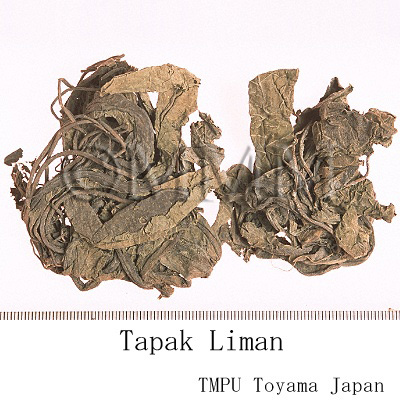Crude drug sample data base
※Click on the image to enlarge it.
Scientific information data base
| Crude drug name | Indonesian name, English name | Daun tapak liman, Elephant's foot | ||||
|---|---|---|---|---|---|---|
| crude drug image |
| |||||
| Original plant name | Elephantopus scaber Linn. | |||||
| Family name | Compositae | |||||
| Used part | Leaves, roots | |||||
| Distribution area | Widespread in tropical America, Africa, Asia, Australia; throughout South-East Asia. It occurs in Java (Indonesia) from lowland up to 1200 m altitude. It is found in the undergrowth of teak forests, in waste places, grasslands, roadsides and forest fringes. They may occur on path in some plantantion and in lawns [201, 205]. | |||||
| Description | Leaves are in a radical rosette, oblong-obovate to spatulate, 5-38 cm x 1-6 cm. The plant is an erect herb up to 80 cm tall, stems rigid, appressed long-haired or scabrous; flowers with corolla 7-9 mm long, bluish or purplish, sometimes white; fruit about 4 mm long [205]. | |||||
| Drug effect | Bitter, cooling, blood cleanser. | |||||
| Specific actions | Anti-inflammatory, antipyretic, diuretic [231]. | |||||
| Frequency in use | Moderate. | |||||
| Pharmacological effect | Deoxyelephantopin significantly inhibited the growth of Walker 256 carcinosarcoma in rats [205]. Water extract of E. scaber decrease the level of serum glutamate-oxalate-transaminase and serum glutamate-pyruvate-transaminase in a study on the hepatoprotective effect against acute hepatic damage in rats induced by beta-D-galactosamine and paracetamol [205]. E. scaber inhibits the growth of both gram-positive and gram-negative bacteria [205]. Sesquiterpene lactones (scabertopin, isoscabertopin, deoxyelephantopin, isodeoxyelephantopin) isolated from Elephantopus scaber Linn. in vitro and in vivo have been studied for their antitumor effect. Results indicated that the activity shown by the compounds is through the induction of apoptosis in vitro. Isodeoxyelephantopin also has antitumor activity in vivo [PMID:16837899]. Study on the efficacy of E. scaber in the prevention of carbon tetrachloride -induced chronic liver dysfunction in the rats showed that the plant has hepatoprotective effect [PMID:11883157]. Aqueous and hydroalcoholic extracts of whole plants of E. scaber were tested for acute toxicity, analgesic, antipyretic, antiinflammatory, cardiovascular, diuretic and constipating activities. Both extracts (0.3-6 g/kg I.p.) induced writhing, loss of muscle tone, ataxia, prostration and death in mice. No analgesic effects of these extracts were detected. Both extracts failed to modify diuresis or carrageenan-induced rat paw edema. Given intraperitoneally, both reduced brewer's yeast-induced hyperthermia in rats, but when given orally did not affect it., the aqueous extract decreased the intestinal transit time in mice while the hydroalcoholic extract increased it. These extracts, given intravenously, reduced blood pressure and heart rate in rats [PMID: 1453704]. | |||||
| Medical system | Indonesian medicine (Jamu) | |||||
| Traditional usage | The leaves are applied as a poultice on the abdomen for curing high fever; it is used also as anthelmintic and aphrodisiac, and to treat cough, sprue and diarrhoea/diarrhea. The root is used to cure malaria. Whole parts of the plant is finely crushed, add some salt and bark of Cinnamomum burmannii, and the juice obtained is used to treat fever in children. The plant is pounded and squeezed on a piece of cloth, the juice obtained is used to cure leuchorrhea (white vaginal discharge) [201, 205]. | |||||
| Formulation | 1) Leucorrhoea/leucorrhea: 2 herbs are boiled with 110 ml of water. Stand to cool and strain. Drink 100 ml of the decoction once a day for 10 days [231]. 2) Wounds: 2 herbs are pounded by adding a small amount of water, squeeze, drink 1/4 cup of the juice once a day for seven days [231]. 3) Uterine inflammation: 7 grams of roots are steeped with 100 ml of boiled water. Stand to cool, strain. Drink 100 ml of the tea once a day for 14 days. It is not recommended for pregnant women [231]. | |||||
| References | Reference book Tips! | [201] K. Heyne, Tumbuhan Berguna Indonesia, Vols. 1-4, 1987. Diedarkan Oleh Koperasi Karyawan Departemen Kehutanan, Jakarta, Indonesia. Vol. 3, p 1824. [205] de Pdua, L.S., Bunyapraphatsara, N. and Lemmens, R.H.M.J. (Editors), 1990. Plant Resources of South-East Asia No. 12 (1). Medicinal and poisonous plants 1. Backhuys Publishers, Leiden, Netherlands. pp 250-254. [231] Soedibyo, Mooryati: Alam Sumber Kesehatan: Manfaat dan Kegunaan (Natural resources for health. Benefits and uses). Balai Pustaka. 1998. p 359. | ||||
| Research paper | 1. Xu G, Liang Q, Gong Z, Yu W, He S, Xi L. Antitumor activities of the four sesquiterpene lactones from EElephantopus scaber L. Exp Oncol. 28(2):106-9, 2006. (PMID: 16837899) 2. Rajesh MG, Latha MS. Hepatoprotection by Elephantopus scaber Linn. in CCl4-induced liver injury. Indian J Physiol Pharmacol. 45(4):481-6, 2001. (PMID: 11883157) 3. Poli A, Nicolau M, Simoes CM, Nicolau RM, Zanin M. Preliminary pharmacologic evaluation of crude whole plant extracts of Elephantopus scaber. Part I: In vivo studies. J Ethnopharmacol. 37(1):71-6, 1992. (PMID: 1453704) | |||||
| Last renewal date | 2024/03/05 | |||||








